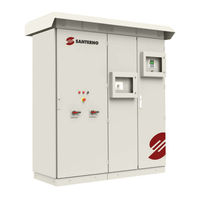Santerno SUNWAY TG1200 1000V TE OD Manuals
Manuals and User Guides for Santerno SUNWAY TG1200 1000V TE OD. We have 1 Santerno SUNWAY TG1200 1000V TE OD manual available for free PDF download: Installation Manual
Santerno SUNWAY TG1200 1000V TE OD Installation Manual (139 pages)
MODULAR SUNWAY TG TE OD OUTDOOR THREE-PHASE PHOTOVOLTAIC INVERTER WITH EXTERNAL TRANSFORMER
Table of Contents
-
-
Symbols Used18
-
Definitions18
-
-
Intended Use20
-
-
Connectivity38
-
-
Packaging41
-
-
-
-
-
-
Datalogger69
-
Serial Link71
-
-
Connection77
-
Com1 Port78
-
8 Optionals
83-
Ac-Side Spds89
-
Fuse-Holders91
-
-
-
Converter Fans101
-
Cabinet Fans102
-
-
-
Self-Diagnostics106
-
-
-
-
Nameplate115
-
-
Inverter Views122
-
-
-
Control Board129
-
-
14 Annexes
139-
Revision Index139
-
Advertisement
